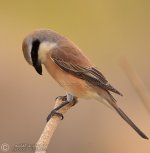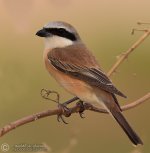-
Welcome to BirdForum, the internet's largest birding community with thousands of members from all over the world. The forums are dedicated to wild birds, birding, binoculars and equipment and all that goes with it.
Please register for an account to take part in the discussions in the forum, post your pictures in the gallery and more.
You are using an out of date browser. It may not display this or other websites correctly.
You should upgrade or use an alternative browser.
You should upgrade or use an alternative browser.
Shrike ID - Saudi Arabia early may (1 Viewer)
- Thread starter khalifa_7
- Start date
More options
Who Replied?Grahame Walbridge
Well-known member
It is definitely a hybrid, presumably Red-backed Shrike x 'Isabelline'. Here is an example of a presumed Red-backed x Turkestan, by far the commonest hybrid pairing.
http://www.birdsofsaudiarabia.com/2014/04/red-backed-x-isabelline-shrike-hybrid.html
Your bird is quite different in appearance, in particular the underparts which look quite peachy, this tone clearly extending to the vent and onto the throat, where it is more patchy and less intense. Also the rectrices are not obvious red/rufous.
Red-backed x Daurian do occur but are said to be less frequent and Red-backed x Brown even rarer.
http://www.birdsofsaudiarabia.com/2014/04/red-backed-x-isabelline-shrike-hybrid.html
Your bird is quite different in appearance, in particular the underparts which look quite peachy, this tone clearly extending to the vent and onto the throat, where it is more patchy and less intense. Also the rectrices are not obvious red/rufous.
Red-backed x Daurian do occur but are said to be less frequent and Red-backed x Brown even rarer.
This must be the rare hybrid between the Red-Backed and Brown Shrike (L. Collurio and L. cristatus cristatus).
Characters of Brown Shrike include the red on rump and underparts, lack of wing bar, and the slightly red tail.
Characters of Red-backed Shrike include the the grey head, saturated red on upperparts and dark tail, and some greyish on rump and tibia.
Characters of Brown Shrike include the red on rump and underparts, lack of wing bar, and the slightly red tail.
Characters of Red-backed Shrike include the the grey head, saturated red on upperparts and dark tail, and some greyish on rump and tibia.
Grahame Walbridge
Well-known member
This must be the rare hybrid between the Red-Backed and Brown Shrike (L. Collurio and L. cristatus cristatus).
Characters of Brown Shrike include the red on rump and underparts, lack of wing bar, and the slightly red tail.
Characters of Red-backed Shrike include the the grey head, saturated red on upperparts and dark tail, and some greyish on rump and tibia.
You could be right, it is quite different in appearance to Red-backed x Turkestan hybrids which typically show a combination of fairly obvious white bases to the pp, less saturated underparts and varying amounts of rufous in the tail/rump.
To add to the pro cristatus features you've listed the rectrices do appear rather narrow but it is a pity you cannot see the precise tail structure as you might expect it to appear more graduated. Having said this I would still be very wary in stating that it must be a Red-backed x Brown hybrid as they are by all accounts very rare.
And what does a Red-backed x Daurian hybrid even look like?
BirdingRob
Brit abroad
Apparently the Russians have done quite a bit of field work in this area. Some it is nearly 20 years old but still valid as it is based on direct field observation. I will see if I can get hold of their description of a hybrid male which I believe the Saudi shrike probably is.
New Data on Interrelations of Red-backed and Brown Shrikes
(Lanius collurio and L. cristatus, Aves) in the Zone of Sympatry
A. P. Kryukov* and S. P. Gureev**
* Institute of Biology and Soil Sciences, Far Eastern Division, Russian Academy of Sciences,
pr. Stoletiya Vladivostoka 159, Vladivostok, 690022 Russia
** Institute of Biology and Biophysics, Tomsk, 634050 Russia
Received August 20, 1996
Abstract—Red-backed (Lanius collurio) and brown shrikes (L. cristatus) are clearly distinguishable species.
A new map of their distribution in the zone of sympatry in Western Siberia is presented. According to field
observation, both species have slight habitat preferences, especially in disturbed sites, and overlapping nesting
periods. One of the species usually prevails in number. Despite differences in phenotypes and mating behavior,
including vocalization, they form mixed pairs that subsequently either separate or produce fertile hybrids. The
first description of a hybrid male with intermediate coloration and size is provided. Distribution of intraspecific
hybridization within the family Laniidae is discussed.
eg
New Data on Interrelations of Red-backed and Brown Shrikes
(Lanius collurio and L. cristatus, Aves) in the Zone of Sympatry
A. P. Kryukov* and S. P. Gureev**
* Institute of Biology and Soil Sciences, Far Eastern Division, Russian Academy of Sciences,
pr. Stoletiya Vladivostoka 159, Vladivostok, 690022 Russia
** Institute of Biology and Biophysics, Tomsk, 634050 Russia
Received August 20, 1996
Abstract—Red-backed (Lanius collurio) and brown shrikes (L. cristatus) are clearly distinguishable species.
A new map of their distribution in the zone of sympatry in Western Siberia is presented. According to field
observation, both species have slight habitat preferences, especially in disturbed sites, and overlapping nesting
periods. One of the species usually prevails in number. Despite differences in phenotypes and mating behavior,
including vocalization, they form mixed pairs that subsequently either separate or produce fertile hybrids. The
first description of a hybrid male with intermediate coloration and size is provided. Distribution of intraspecific
hybridization within the family Laniidae is discussed.
eg
Thanks Grahame. You are right I should have said probably.
I got the following from the paper you mentioned above, which describes the L. Collurio X L. Cristatus hybrid. It describes a similar bird to ours.
The forehead and anterior part of the upper head region are gray with clear brownish tint. Beak and skin on the beak are black. The latter is joined with a black band above the beak. White eyebrow wider is to ear parts. Brown color on the posterior part of neck and nape, to the level of shoulders, is more intense than on the forehead, then the back and upper part of tail arestill more brown. Dorsal coloration not so bright as usually in L. collurio, and corresponds to coloration of L. cristatus. Oar feathers are dark-brown, external vanes of the third-order oar feathers have light-brown edges. Mirror bright, white, but completely hidden with covering feathers when the wing is folded. Crop and throat white, as in both species. Breast and belly sides intensively pinkish-brown. This coloration is intermediate between that of L. collurio and L. cristatus. Middle of belly and inner part of tail almost white. Middle fail feathers are dark brown, and the tail from above resembles that in L cristatus. Apical spots on all other fail feathers have the same coloration. On the outer fail feathers, spots are 18 and 27 mm in length on the left and right side, respectively. All fail feathers are white at the base, except for the middle pair, but the white zone become narrower from the periphery to the center of the fail. Therefore, the tail resembles that of L. collurio in pigment distribution but contains brown areas instead of black ones. Four pairs of outer fail feathers are with preapical dark-brown stripes and white apical edgings. The shafts are light from below, like in L. cristatus. All plumage is fresh except of old middle rudders.
In general, this specimen has intermediate coloration of the upper part of head, breast, and tail. From the first view, it resemble hybrids between L. collurin and L. phoenicuroides or L. collurio and L. i. speculigerus. Their highly variable populations live not far, about 600-800 km away in the Eastern Kazakhstan and South Eastern Altai (Panov and Kryukov, 1973), from where the immigration could taken place. However, in difference to L. phoenicuroides, the lower part of the body in our specimen is not white, the fail is not so red; unlike L. speculigerus, this bird has a small mirror. In addition to coloration, obviously staggered tail and other dimensional traits indicate the involvement of L. collurio genes.
Also the book titled “Handbook of Avian Hybrids of the World” by Eugene M McCarthy 2006 mentions 10 hybrids as follows:
Lanius collurio [Red-backed Shrike] × Lanius cristatus () [Brown Shrike]
ONHR (Siberia). HPF. BRO: e West Siberian Plain (on the upper Ob and w of Yenisei R. at about 80°E). This hybrid was treated as a species (Lanius dichourus). See Figure 9. Ackermann 1898; Kryukov and Gureev 1997; 216 Handbook of Avian Hybrids of the World Mauersberger 1971a; Mayr 1942; Meise 1928a; Panov 1989; Stegmann 1930; Suchetet 1897a; Sushkin 1929.
I got the following from the paper you mentioned above, which describes the L. Collurio X L. Cristatus hybrid. It describes a similar bird to ours.
The forehead and anterior part of the upper head region are gray with clear brownish tint. Beak and skin on the beak are black. The latter is joined with a black band above the beak. White eyebrow wider is to ear parts. Brown color on the posterior part of neck and nape, to the level of shoulders, is more intense than on the forehead, then the back and upper part of tail arestill more brown. Dorsal coloration not so bright as usually in L. collurio, and corresponds to coloration of L. cristatus. Oar feathers are dark-brown, external vanes of the third-order oar feathers have light-brown edges. Mirror bright, white, but completely hidden with covering feathers when the wing is folded. Crop and throat white, as in both species. Breast and belly sides intensively pinkish-brown. This coloration is intermediate between that of L. collurio and L. cristatus. Middle of belly and inner part of tail almost white. Middle fail feathers are dark brown, and the tail from above resembles that in L cristatus. Apical spots on all other fail feathers have the same coloration. On the outer fail feathers, spots are 18 and 27 mm in length on the left and right side, respectively. All fail feathers are white at the base, except for the middle pair, but the white zone become narrower from the periphery to the center of the fail. Therefore, the tail resembles that of L. collurio in pigment distribution but contains brown areas instead of black ones. Four pairs of outer fail feathers are with preapical dark-brown stripes and white apical edgings. The shafts are light from below, like in L. cristatus. All plumage is fresh except of old middle rudders.
In general, this specimen has intermediate coloration of the upper part of head, breast, and tail. From the first view, it resemble hybrids between L. collurin and L. phoenicuroides or L. collurio and L. i. speculigerus. Their highly variable populations live not far, about 600-800 km away in the Eastern Kazakhstan and South Eastern Altai (Panov and Kryukov, 1973), from where the immigration could taken place. However, in difference to L. phoenicuroides, the lower part of the body in our specimen is not white, the fail is not so red; unlike L. speculigerus, this bird has a small mirror. In addition to coloration, obviously staggered tail and other dimensional traits indicate the involvement of L. collurio genes.
Also the book titled “Handbook of Avian Hybrids of the World” by Eugene M McCarthy 2006 mentions 10 hybrids as follows:
Lanius collurio [Red-backed Shrike] × Lanius cristatus () [Brown Shrike]
ONHR (Siberia). HPF. BRO: e West Siberian Plain (on the upper Ob and w of Yenisei R. at about 80°E). This hybrid was treated as a species (Lanius dichourus). See Figure 9. Ackermann 1898; Kryukov and Gureev 1997; 216 Handbook of Avian Hybrids of the World Mauersberger 1971a; Mayr 1942; Meise 1928a; Panov 1989; Stegmann 1930; Suchetet 1897a; Sushkin 1929.
Ilya Maclean
charlatan
I'm given to understand the wing and tail formulae are quite important when IDing shrikes
The wing formula is much closer to 'Isabelline' (see here), although perhaps that's what one would expect of a Red-backed x Brown. That said, the overall primary projection, short on Brown, just seems wrong to me. It looks much more like what one would expect on an 'Isabelline' or Red-backed.
Also, the tail seems too square for me to see much Brown Shrike influence. Certainly I can't see any evidence of short outer tail feathers - a characteristic feature of Brown Shrikes.
The wing formula is much closer to 'Isabelline' (see here), although perhaps that's what one would expect of a Red-backed x Brown. That said, the overall primary projection, short on Brown, just seems wrong to me. It looks much more like what one would expect on an 'Isabelline' or Red-backed.
Also, the tail seems too square for me to see much Brown Shrike influence. Certainly I can't see any evidence of short outer tail feathers - a characteristic feature of Brown Shrikes.
Last edited:
Grahame Walbridge
Well-known member
I'm given to understand the wing and tail formulae are quite important when IDing shrikes
The wing formula is much closer to 'Isabelline' (see here), although perhaps that's what one would expect of a Red-backed x Brown. That said, the overall primary projection, short on Brown, just seems wrong to me. It looks much more like what one would expect on an 'Isabelline' or Red-backed.
Also, the tail seems too square for me to see much Brown Shrike influence. Certainly I can't see any evidence of short outer tail feathers - a characteristic feature of Brown Shrikes.
Ilya, only the central two pairs are visible, the remainder t1-t4 on both sides are hidden underneath which is fairly typical. These are the important ones with regards assessing precise structure and pigment distribution.
Grahame Walbridge
Well-known member
Sorry, of course I meant t6-t3 are concealed.
Users who are viewing this thread
Total: 2 (members: 0, guests: 2)






